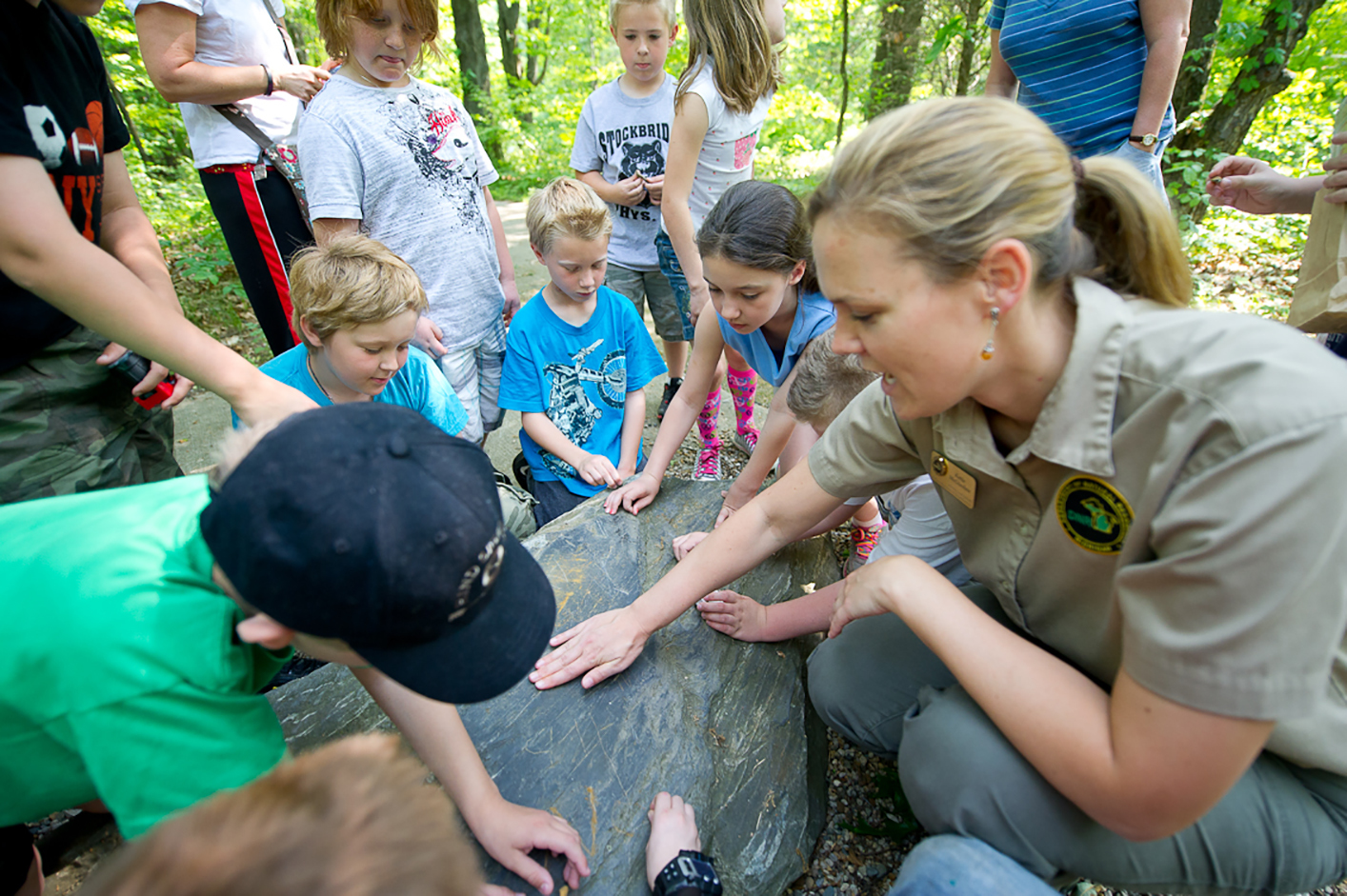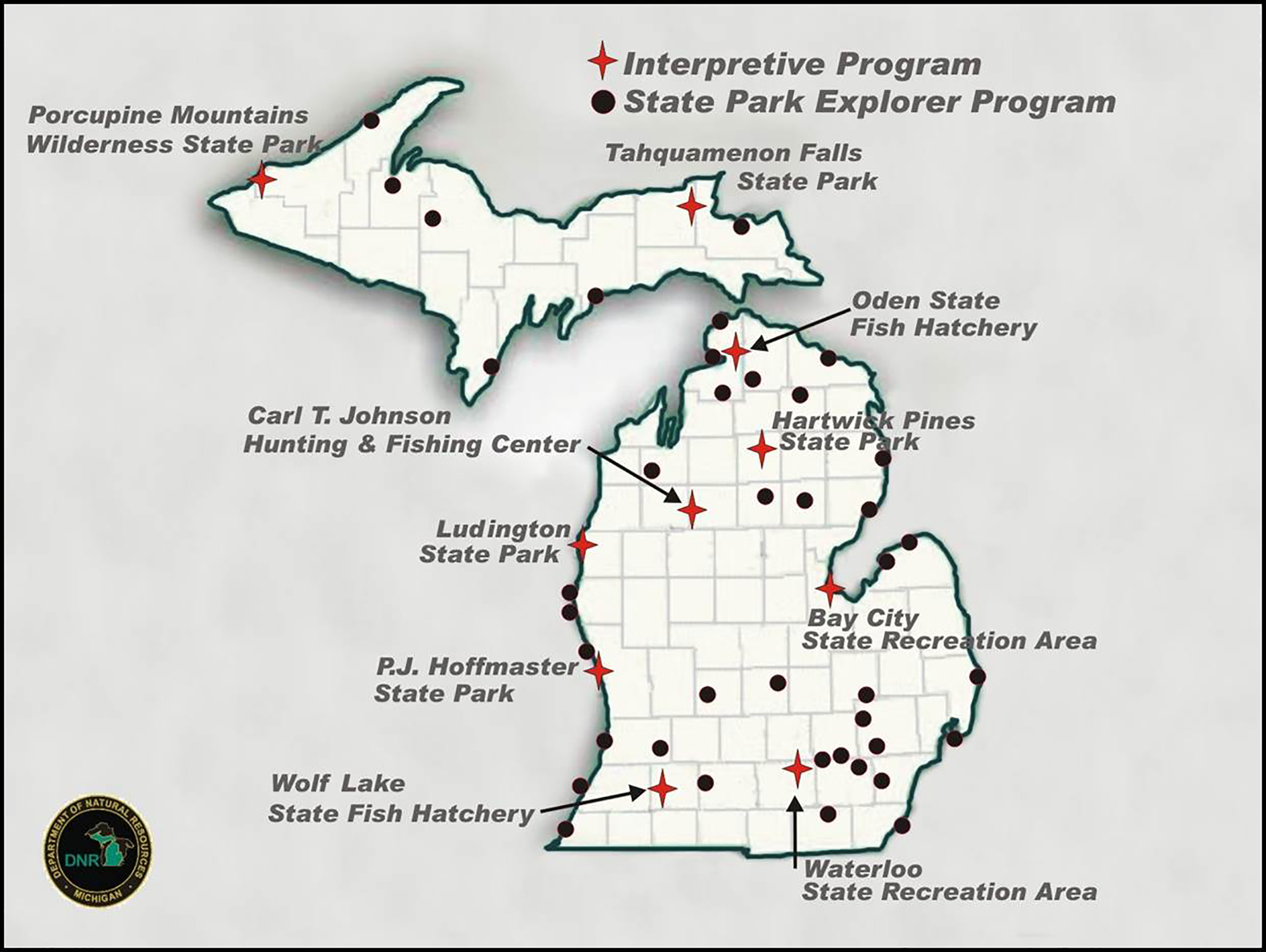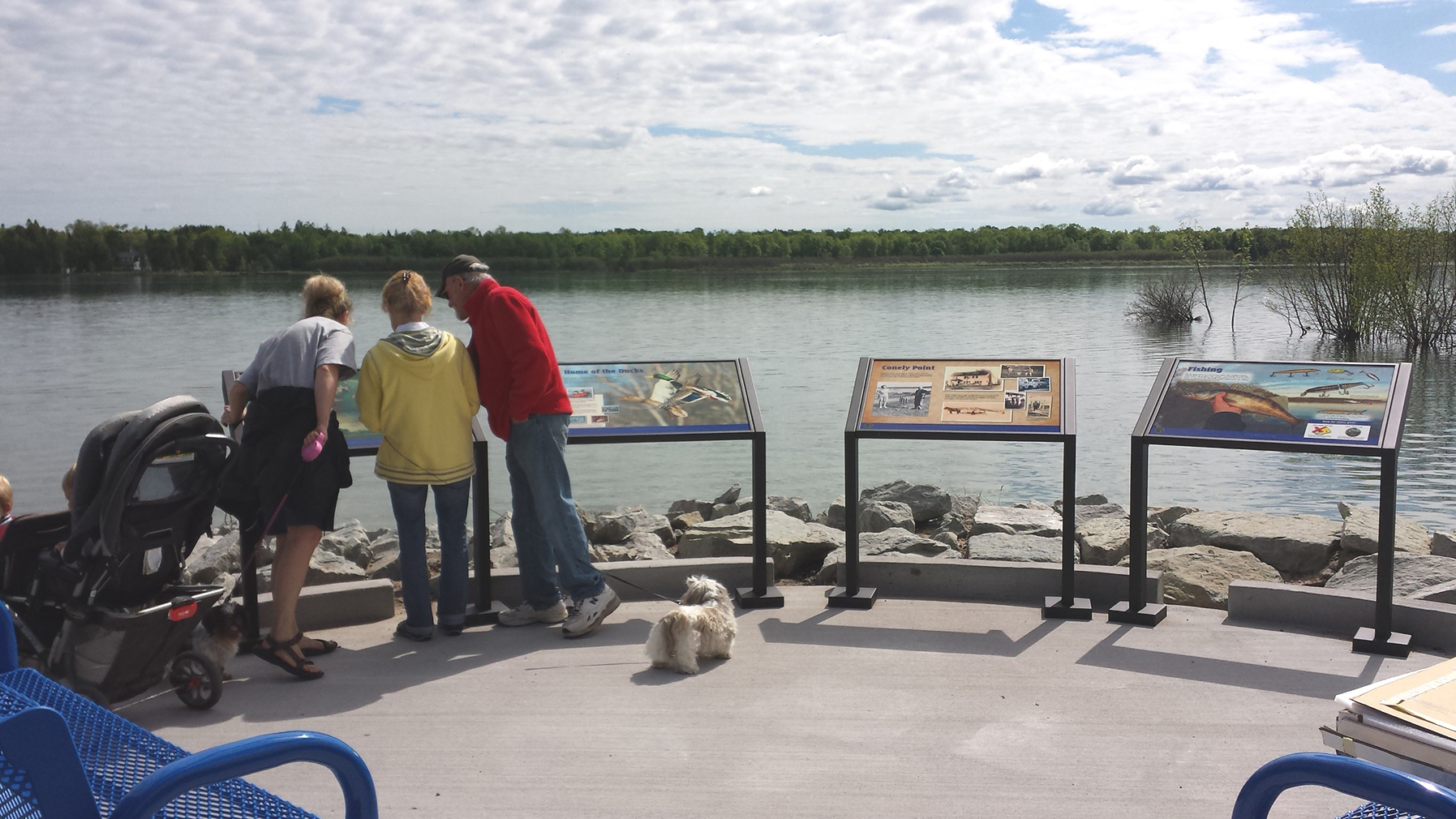DNR education programs connect people to the outdoors
In Michigan, you’re never more than an hour's drive from a state park or recreation area.
As the millions of annual visitors to our state parks and recreation areas know, these places offer an abundance of ways to enjoy the outdoors – from hiking and biking to swimming and stargazing.
 Perhaps lesser known is that, in most areas of the state, you’re not too far away from opportunities to discover more about the outdoors with the Michigan Department of Natural Resources’ nature and outdoor education programs. Perhaps lesser known is that, in most areas of the state, you’re not too far away from opportunities to discover more about the outdoors with the Michigan Department of Natural Resources’ nature and outdoor education programs.
The DNR’s 10 visitor centers around the state feature fun and educational nature exhibits, access to nearby trails and engaging outdoor experiences with professional interpreters that lead nature-oriented programs.
In 2016, nearly 400,000 visitors stopped in to one of the statewide visitor centers to take in exhibits, attend a program or experience a trail hike, said DNR education services manager Kevin Frailey.
“More than 100,000 participated in a scheduled program, about half of which were school children,” said Frailey. “Thousands were introduced to archery through our Arrows Away programs and learned to fish in one of many Hook, Line and Sinker angling experiences. Other programs ranged from dune ecology to old-growth forests.”
Many of the educational experiences available at the visitor centers focus on the unique natural and cultural features of the location.
At Ludington State Park, along Lake Michigan in the northern Lower Peninsula, interpretive programming dates back to 1969 and over the years has taught millions of visitors about the park’s rich history, as well as its variety of outdoor recreation opportunities.
“The park is full of history dating back to the Native American villages, European explorers like Father Marquette, logging-era village with sawmills, one of the earliest lighthouses built on Lake Michigan, a Depression-era Civilian Conservation Corps camp, and restoration of the Lake Michigan Beach House,” said Alan Wernette, Ludington State Park interpreter.
 In 2016, the DNR completed design and installation of new exhibits, focusing on Great Lakes ecology, at the recently renovated historic beach house at Ludington State Park. In 2016, the DNR completed design and installation of new exhibits, focusing on Great Lakes ecology, at the recently renovated historic beach house at Ludington State Park.
The Hartwick Pines State Park Visitor Center in Grayling draws thousands of visitors, campers and school children each year to see one of Michigan's last stands of majestic old-growth pine forest.
Visitors also flock there for the chance to see one of North America’s rarest birds, the Kirtland’s warbler, with tours held out of the visitor center in late spring and early summer.
“We recently had a tour with more than 30 people who came from several different states in the U.S. as well as a few from the U.K.,” said Craig Kasmer, park interpreter at Hartwick Pines State Park. “We had been birding since 8 a.m. and finally at 11:30, one of the singing males alighted on top of a jack pine and threw back his head and sang for all to see (and hear).
“We have been doing Kirtland’s warbler tours out of the visitor center for four years, and this is the first time that I have seen grown adults gasp and squeal when they saw him sing.”
While most visitors to Tahquamenon Falls State Park in the eastern Upper Peninsula come to see two of Michigan's most beautiful waterfalls, park education programs help participants explore the park’s other natural features as well.
The Werner family, who visited the park last summer and took part in programs including a guided hike, offered the following feedback about their experience:
“Just wanted to thank you for making Tahquamenon Falls come alive for us. Instead of walking down to the falls to see dirty water, we saw runoff from the hemlock trees. We saw beaver chews, beech and birch trees, and woodpecker holes. Our walks through the woods will never be the same. We will be looking for signs of animals, beaver slides, dams and chews. We will look for tracks and enjoy the different flowers. We will listen for the sound of the birds singing and look for dead trees in hopes of seeing the pileated woodpecker.”
Other visitor centers include the Carl T. Johnson Hunt and Fish Center at Mitchell State Park in Cadillac, the Eddy Discovery Center at Waterloo Recreation Area near Chelsea, the Gillette Visitor Center at Hoffmaster State Park in Muskegon, Oden State Fish Hatchery Visitor Center near Petoskey, Porcupine Mountains Visitor Center at Porcupine Mountains Wilderness State Park near Ontonagon, the Saginaw Bay Visitor Center at Bay City State Recreation Area in Bay City and the Wolf Lake State Fish Hatchery Visitor Center in Mattawan.
Check out cool videos on the Carl T. Johnson Hunt and Fish Center and the Hartwick Pines Visitor Center.
In more than 40 Michigan state parks that do not have visitor centers, the DNR’s State Park Explorer Program offers educational and entertaining nature programs for park visitors.
More than 77,000 state park campers and visitors took part in the Explorer Program in the summer of 2016.
“Fishing is one of the most popular events, and specialized theme weeks like Michigan Mammals and Feathered Friends were extremely popular,” said Frailey.
When not conducting a formal program or trail hike, many of the Explorer Program guides roam the campgrounds or choose heavily trafficked areas to intercept park visitors with a skull, pelt or other interesting prop for an impromptu education experience.
Frailey said that last summer, roving naturalists impacted more than 120,000 park visitors.
Even in locations where staff isn’t available to lead an educational experience, the DNR offers visitors a chance to learn something while enjoying the outdoors.
“At many sites that do not have on-site, first-person interpretation, visitors rely on wayside graphics and displays, designed by DNR interpretive staff, to enhance their visit,” said Theresa Neal, park interpreter at Tahquamenon Falls State Park.
Neal cited the example of the recently completed Conely Point Boating Access Site, located on the St. Marys River in the Upper Peninsula, which includes an accessible seating area to view the water, along with four wayside graphics interpreting the wildlife, fishing and history of the area.
 The overarching goal of the DNR’s education programs is to connect people to Michigan’s natural and cultural resources. The overarching goal of the DNR’s education programs is to connect people to Michigan’s natural and cultural resources.
“We’re aiming for Michigan citizens to understand that the state’s natural and cultural resources belong to them and are managed professionally by the DNR to ensure that current and future generations can use and enjoy them,” said Jon Spieles, DNR field manager for educational services. “We also want people to understand how important sound management of Michigan’s natural and cultural resources is to our ecosystems, economies and quality of life.”
DNR education programs are helping Michigan citizens gain a better understanding of some of the issues facing natural resources managers, including invasive species.
“Invasive species are arguably the number one threat to natural resources in the world, and certainly in Michigan,” said Spieles. “We thread this critical topic through almost every program we do.”
Last year, all DNR visitor centers installed a three-dimensional Asian long-horned beetle exhibit complete with an interactive game.
“Already, thousands of visitors have tried to ‘capture’ the invasive beetle and become aware of the potential threat of this bug,” said Frailey.
Nearly all the visitor centers also have installed aquariums and use live sea lamprey to educate the public about the impact of these non-native invaders.
“Sea lamprey are not only Michigan’s first impactful invasive species, but their snakelike bodies and rasping mouth parts make them a hit with audiences,” Frailey said.
The DNR education staff hopes to arm visitor center attendees and program participants with the knowledge to help combat some of the threats to Michigan’s natural resources.
“We want people to come away from our programs knowing what chronic wasting disease is and how they can help the DNR keep it from spreading, for example, or that they shouldn’t prune oak trees in the spring to prevent the spread of oak wilt,” Spieles said.
Another DNR education objective is for visitors and program participants to discover that outdoor recreation and use of our natural resources is fun and healthy for all ages and abilities.
“Part of our job is to help people become more comfortable in the outdoors so they’ll feel more connected to our natural resources and have more of a stake in conserving them – recreation makes that connection,” Spieles said.
In addition to the nature-based recreation programming regularly offered at the visitor centers and state parks, for those looking to take a step beyond an introduction to outdoor recreation, the DNR offers the Outdoor Skills Academy.
These popular classes, which began at the Carl T. Johnson Hunt and Fish Center in Cadillac and recently expanded to other visitor center locations around the state, offer expert instruction, gear and hands-on learning for a range of outdoor activities, from hunting and fishing to hiking, birding and more.
“Whether you need some help getting started with a new outdoor activity or want to brush up on your skills and learn some tips and tricks, we can help,” said Spieles. “Outdoor Skills Academy classes are unique in that they explore these topics in-depth – for a full day or more, with knowledgeable and skilled instructors leading the way – at an affordable cost.”
Find more information on DNR nature and outdoor education programs at michigan.gov/dnreducation.
Check out previous Showcasing the DNR stories and subscribe to upcoming articles.
/Note to editors: Contact: John Pepin 906-226-1352. Accompanying photos are available below for download and media use. Suggested captions follow. Credit: Michigan Department of Natural Resources, unless otherwise noted.
Archery: Thousands of state park visitors are introduced to archery every year through the Michigan Department of Natural Resources’ Arrows Away program.
Conely Point: Conely Point Boating Access Site, on the St. Marys River in the Upper Peninsula, features displays that help visitors learn more about the wildlife, fishing and history of the area.
Eddy: Participants in a nature education program at Eddy Discovery Center, located in Waterloo Recreation Area near Chelsea, learn about geology.
Fishing: Fishing experiences are among the more popular DNR education programs at state parks, recreation areas and hatcheries.
Hoffmaster: Kids learn about sand dunes during a nature education program at the Gillette Visitor Center, located in Muskegon’s Hoffmaster State Park.
Kirtland’s Tour: Visitors come from other states, and even other countries, to catch a glimpse of the rare Kirtland’s warbler during tours led by staff at the Hartwick Pines State Park Visitor Center in Grayling.
Map: A map graphic shows the locations of state park explorer programs and interpretive programs in Michigan.
Outdoor Skills Academy: The Michigan Department of Natural Resources’ Outdoor Skills Academy offers in-depth, hands-on outdoor recreation classes – like this steelhead fishing clinic held at the Carl T. Johnson Hunt and Fish Center in Cadillac’s Mitchell State Park – at locations around the state.
Porkies: Visitors to Porcupine Mountains Wilderness State Park in the western Upper Peninsula go on a guided hike to explore the rich wilderness heritage of the 60,000-acre park.
Upper Falls: Education programs at Tahquamenon Falls State Park in the eastern Upper Peninsula help visitors learn more about the park’s many features, including two of Michigan's most beautiful waterfalls.
Wolf Lake: Education programs at the Wolf Lake State Fish Hatchery Visitor Center, west of Kalamazoo, include hatchery tours where visitors can discover how the Michigan Department of Natural Resources raises millions of fish every year to stock Michigan’s lakes, rivers and streams./
The Michigan Department of Natural Resources is committed to the conservation, protection, management, use and enjoyment of the state’s natural and cultural resources for current and future generations. For more information, go to www.michigan.gov/dnr.
|

 Perhaps lesser known is that, in most areas of the state, you’re not too far away from opportunities to discover more about the outdoors with the Michigan Department of Natural Resources’ nature and outdoor education programs.
Perhaps lesser known is that, in most areas of the state, you’re not too far away from opportunities to discover more about the outdoors with the Michigan Department of Natural Resources’ nature and outdoor education programs. In 2016, the DNR completed design and installation of new exhibits, focusing on Great Lakes ecology, at the recently renovated historic beach house at Ludington State Park.
In 2016, the DNR completed design and installation of new exhibits, focusing on Great Lakes ecology, at the recently renovated historic beach house at Ludington State Park.
 The overarching goal of the DNR’s education programs is to connect people to Michigan’s natural and cultural resources.
The overarching goal of the DNR’s education programs is to connect people to Michigan’s natural and cultural resources.





